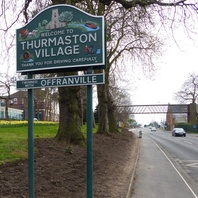
Viking Names
Thurmaston
Thurmaston, in the East Goscote Hundred of Leicestershire, is an Anglo-Scandinavian hybrid from the common Old Norse male personal name Þormóðr and Old English tun ‘an enclosure; a farmstead; a village; an estate’. A few thirteenth and fourteenth century spellings of Thurmaston seem influenced by the Old Norse male personal name Þormundr. A large pagan, Anglian cemetery has been discovered here, no doubt that of an important early settlement site preceding Scandinavian appropriation.
Read More

Viking Talks
Assembling Vikings: Thinking Through Things in the East Midlands
A feature of the Viking diaspora was the establishment of Thing sites, places of regular popular gatherings, where disputes were settled and justice was done. As well as the famous examples of the Icelandic Althing, Tinganes in the Faroe Islands, and Tynwald on the Isle of Man, other examples are known from regions of northern Europe settled by Scandinavians, including examples in the East Midlands, such as Thynghowe (now Hanger Hill) in Sherwood Forest, Nottinghamshire. This tradition of public assembly was shared by the Anglo-Saxons, who sometimes used the same word to describe such meetings. Using place-names and field-work, we can learn more about these important sites of local governance. Dr John Baker Wednesday 6 December 2017
Read More

Viking Talks
Viking Hoards and the Making of England
The conventional history of the unification of England is largely derived from records written at the West Saxon court. According to this version of events, the people of Mercia and Northumbria gratefully accepted the rule of Alfred the Great of Wessex and his descendants as saviours against the hated Vikings. Viking hoards, and the coins within them, suggest a more complex situation. This lecture re-evaluates the process of unification in the light of new hoard evidence, including the important hoards from Watlington and the Vale of York, on display together for the first time. Dr Gareth Williams Monday 11 December 2017
Read More

Viking Talks
The Gleam of Silver: Vikings, Coins and Hoards
Hoards are some of the clearest and most spectacular remnants of the Viking presence in Britain. A group of seven hoards will be displayed in the exhibition ‘Viking: Rediscover the Legend’, one of the largest collections of Viking silver ever displayed. This talk will interpret the silver and coinage that they contain, using them to argue that the Vikings transformed Britain. Dr Andrew Woods Wednesday 14 February 2018
Read More
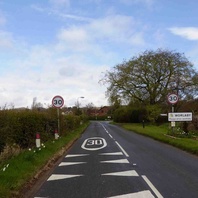
Viking Names
Worlaby
Worlaby, in the Yarborough Wapentake of Lincolnshire, is a hybrid name coming from the Old English male personal name Wulfric and Old Norse by ‘farm, settlement’, identical with Worlaby in the Hill Wapentake of Leicestershire, now a lost village. The two Domesday book spellings in Ulu- are presumably Scandinavianised forms.
Read More
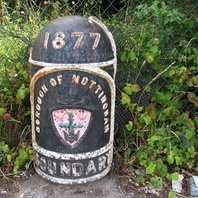
Viking Names
Nottingham
Nottingham is one of the Five Boroughs of the Danelaw. The place-name is comprised of three Old English elements: the male personal name Snot, ingas ‘people of, the people called after’ and ham ‘a village, a village community, a manor, an estate, a homestead’. Thus the name means ‘Homestead/village of Snot’s people’. It is likely that the same man or people gave his name to the adjacent Sneinton. There is an older British name for Nottingham, Tigguocobauc ‘house of caves, cavy house’, alluding to the sandstone caves of Castle Hill. However, there is no other record for this name outside of Asser’s reference for 868. According to the Anglo-Saxon Chronicle, Nottingham was occupied by the Great Heathen Army in 867 and remained under Scandinavian control until 918, when it was occupied by Edward the Elder. The influence of these Vikings can be seen in the city of Nottingham’s street names. The Old Norse element gata ‘path, way, road’ can be found in street names such as Barker Gate ‘street of the barkers or tanners’, Castle gate ‘street leading to the castle’, and Fisher Gate ‘street of the fishermen’.
Read More
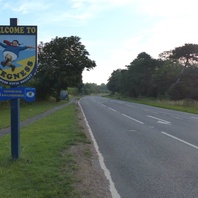
Item
Skegness
Skegness, in the Candleshoe Wapentake of Lincolnshire, is a Scandinavian compound, but the meaning of the place-name is uncertain. One suggestion is ‘Skeggi’s headland’ from the Old Norse male personal name Skeggi and the Old Norse element nes ‘ a ness, a headland, a promontory’. More likely, the first element could be the Old Norse element skegg ‘beard’, ‘something jutting out’, which is related to the verb skaga and the topographical term skagi ‘promontory’. This Old Norse appellative is probably found in the two Skegby place-names in Nottinghamshire.
Read More
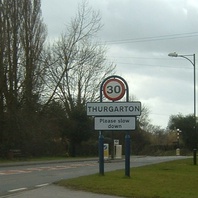
Viking Names
Thurgarton
Thurgarton, in the Thurgarton Wapentake of Nottinghamshire, comes from the Old Norse male personal name Þorgeirr (though in an anglicised form Þurgar) and the Old English element tun ‘farm, settlement’, and is thus a hybrid name.
Read More
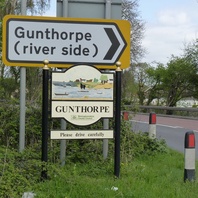
Viking Names
Gunthorpe
Gunthorpe, in the Thurgarton Wapentake of Nottinghamshire, comes from the Old Norse female personal name Gunnhildr and the Old Norse element þorp ‘outlying farm/settlement’.
Read More
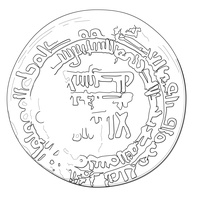
Viking Designs
Drawing of an Arabic Coin
Drawing of an Arabic silver dirham minted in the Middle East and probably brought to Lincolnshire by Viking traders. The dirham was a unit of weight used across North Africa, the Middle East, and Persia, with varying values which also referred to the type of coins used in the Middle East during the Viking Age. These coins were extremely prized possessions not only for their silver value but as a way of displaying one’s wealth and vast trade connections. Millions of Arabic Dirhams would have been imported throughout the Viking world and are mostly found in hoards. Arabic dirhams demonstrate contact between the Viking diaspora and the Arabic world. Arabic coins are especially useful for dating sites, because they carry the date when they were minted. This permits precise dating where the part of the coin with the date survives, whereas European coins can only be dated to the reign of the ruler depicted on them. In western descriptions of these coins, the Arabic dates found on the coins are usually listed in square brackets, as above, and the European equivalent is listed after it.
Read More
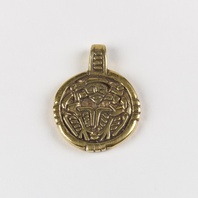
Viking Objects
Reproduction Pendant with an Odin Motif
This reproduction of a cast silver, gilded pendant featuring an image of a one-eyed figure with two birds has been interpreted as Odin and his two ravens, Huginn and Muninn. The original pendant was found at Winteringham, Lincolnshire. There are a number of close parallels which establish the wide currency of this subject group. These include numerous examples from Russia and two from Sweden, including some with silver gilding. A silver pendant with a related, but distinct design is known from Sjælland, Denmark.
